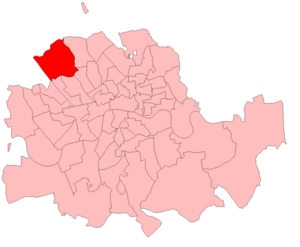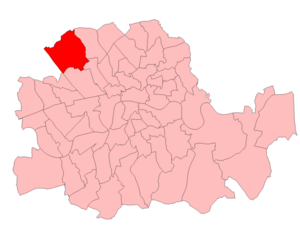Hampstead (UK Parliament constituency) facts for kids
Quick facts for kids {{{Name}}}[[{{{Type}}} constituency]] |
|
|---|---|
| [[Image:{{{Map1}}}Constituency.svg|120px|]] [[Image:England{{{Map2}}}.svg|120px|]] |
|
| {{{Name}}} shown within [[{{{Entity}}}]], and {{{Entity}}} shown within England | |
| Created: | {{{Year}}} |
| MP: | {{{MP}}} |
| Party: | {{{Party}}} |
| Type: | House of Commons |
| County: | [[{{{County}}}]] |
| EP constituency: | [[{{{EP}}} (European Parliament constituency)|{{{EP}}}]] |
Hampstead was a special area in North London that had its own representative in the Parliament of the United Kingdom. This area was called a borough constituency. Think of it like a team in a sports league; Hampstead was one team, and it got to send one player, called a Member of Parliament (MP), to the main game, the House of Commons.
The MP for Hampstead was chosen using a system called first-past-the-post. This means the candidate who gets the most votes wins, even if they don't get more than half of all the votes.
The Hampstead constituency was first created for the election in 1885. It existed for many years until it was stopped for the 1983 election. After that, parts of it became part of a new area called the Hampstead and Highgate constituency.
Contents
How Hampstead's Boundaries Changed
The area that the Hampstead MP represented changed a few times over the years.
Early Days: 1885 to 1918
When the Hampstead constituency was first created in 1885, it covered just the area known as the civil parish of St John, Hampstead. Before this, Hampstead was part of a larger area called Parliamentary County of Middlesex.
In 1889, Hampstead became part of the new County of London. Then, in 1900, the county was divided into smaller areas called metropolitan boroughs. The civil parish of Hampstead became the Metropolitan Borough of Hampstead.
Changes in the 1900s
New rules for parliamentary areas were made in 1918. In London, these new boundaries matched the metropolitan boroughs. So, the Hampstead constituency became exactly the same size as the Metropolitan Borough of Hampstead.
Later, in 1948, the name "parliamentary borough" was changed to "borough constituency." The Hampstead Borough Constituency kept the same boundaries. These changes started with the 1950 general election.
In 1965, the County of London and its metropolitan boroughs were removed. Hampstead then became part of a bigger area called the London Borough of Camden. The parliamentary boundaries didn't change right away, but they did in 1970.
The constituency was officially renamed "Camden, Hampstead Borough Constituency." It included seven smaller areas, or wards, of the London Borough. These were Adelaide, Belsize, Hampstead Town, Kilburn, Priory, Swiss Cottage, and West End. In 1973, the wards changed slightly, with Swiss Cottage ward replacing Hampstead Central. These boundaries were used until 1983, when the Hampstead seat was closed down.
Who Represented Hampstead?
Here are the people who served as the Member of Parliament (MP) for Hampstead:
| Election | Member | Party | |
|---|---|---|---|
| 1885 | Sir Henry Holland | Conservative | |
| 1888 by-election | Edward Hoare | Conservative | |
| 1902 by-election | Thomas Milvain | Conservative | |
| 1905 by-election | John Fletcher | Conservative | |
| 1918 | George Balfour | Coalition Conservative | |
| 1922 | Conservative | ||
| 1941 by-election | Charles Challen | Conservative | |
| 1950 | Henry Brooke | Conservative | |
| 1966 | Ben Whitaker | Labour | |
| 1970 | Geoffrey Finsberg | Conservative | |
| 1983 | constituency abolished: see Hampstead & Highgate | ||
Images for kids









